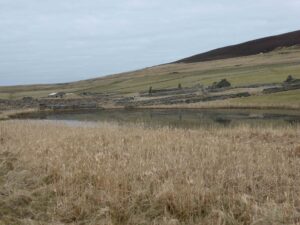
In the past (less so today), I was often approached by anxious parents, wondering about their child’s choice of archaeology as a subject for university study. One of my points was that, whatever your ultimate career, a degree in archaeology would enrich you for life. Not only were there all the usual platitudes about learning, thinking and research; more important was the point that, once you had studied archaeology, a walk in the countryside would never be the same again. And walking in the countryside is popular for many reasons.
It never ceases to amaze me how much there is to see in a piece of land once you have got your eye in. This point was admirably made by Dan Lee of the Archaeology Institute at UHI in Orkney recently when he led a group of us round the cleared community of Quandale on Rousay which he has been studying for a while now. There was just so much to see in the landscape: ruined steadings; burnt mounds; field dykes; barrows; tombs. The remains spanned at least four thousand years and spoke of the human condition: survival; success; tragedy; expansion; eviction; farming; life and death. Over the years, archaeology has made my countryside exploration so much more meaningful.
But there is a problem with this. When we focus on the remains that we can see, we recognise the traces of many, many past generations, but equally, we ignore the traces of many others. Prior to the mid fourth millennium BC most communities left no upstanding footprint to mark their passing. And Scotland has been inhabited since at least the tenth millennium, probably before.
The hunter-gatherers who inhabited the land before the advent of farming were just as significant as those who came after. But their traces are harder to find. They may be buried under peat, or subsumed below more recent remains. They are rarely obvious on the surface. For a discussion of this, have a read of the fieldwork section of the Palaeolithic and Mesolithic Report in ScARF. All too often we ignore the problem of finding these early sites, but by doing so we are in danger of losing an important part of our past.
Even where we do locate early material, it can be hard to deal with it effectively. We have a good management system for archaeology in Scotland based upon the work of two groups: Historic Environment Scotland (recently cut free from the Scottish Government, but still obliged to undertake statutory work); and Local Authority Archaeologists (whose knowledge of a region or country is rarely beaten). Yet this system is designed to look after upstanding, built features. Houses, tombs, roadways, earthworks: if people have made them we can protect and record them. But the hunters who lived here thousands of years ago rarely left upstanding monuments. They had a more subtle approach to altering the earth. Their mark is left in hearths, postholes, and flints. Especially flints, lots of flints.
When we find flints (or any other lithic tools), it can be harder to know what to do with them. Statutory protection such as scheduling, is more difficult to enforce for a lithic scatter. At the time of writing it has never been done. It would be nice to see this situation remedied as a starter action by the new heritage body Historic Environment Scotland; it would enable it to make a significant mark on the legacy of good heritage protection and management that it has inherited from its predecessors. It would show that it is set to move things forward.
For the rest of us, we need to broaden the scope of our eye when we are out in the landscape. As long as we mentally prioritize the remains that lie above the ground we are missing the full extent of the richness and depth that lies around us. It is possible to develop a ‘Mesolithic eye’ and see the landscape through a reverse filter that restores an ancient topography. I’d love this to become as natural as the desire to see the remains of Medieval settlement or Neolithic ceremony.
You must be logged in to post a comment.